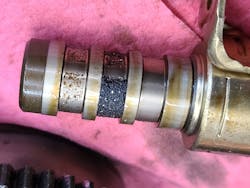Variable Valve Timing or VVT is being used on most engines today, and for good reason. It provides the engine with the best camshaft timing under a myriad of operating conditions. On the non-VVT engine, the camshaft timing in relation to the crankshaft is fixed, forcing the engineers to often compromise on camshaft design. Most drivers expect a smooth idle quality and good engine performance, but the manufacturer is looking for fuel economy and low emissions, hence the need to compromise.
Using VVT allows the engineers to enhance the power output of the engine, and to improve torque delivery across the entire operational rpm range. The introduction to VVT to the internal combustion engine allowed engineers to use a given camshaft on an engine and get the best of both worlds.
The VVT that we are most familiar with is the Continuous Camshaft Phasing VVT. It will continuously advance or retard direction the camshaft’s base timing location in relation to the crankshaft. The most generic form of VVT varies the camshaft timing using a single hydraulic camshaft phaser on each camshaft. It is a simple, basic and less expensive way to produce the system. Nonetheless this system has limitations. It cannot vary the camshafts’ valve opening duration or change the amount of valve lift. But the biggest limitation to this system is the fact that it will not function when the engine is cold or when there is low oil pressure.
The most common VVT system uses the engine’s pressurized oil system to hydraulically activate the VVT camshaft phasers. Because the VVT system depends on the engine’s oil for functionality, any concerns in the engine’s oil system will adversely affect the VVT system. Low oil pressure, low oil level, incorrect oil viscosity, over-extended service intervals and many other oil-related concerns can and do affect the ability of the VVT system to function properly. We have all heard of, read about or personally experienced a VVT issue that was completely preventable with just simple maintenance. Many techs have dealt with MIL complaints, drivability concerns and engine noises only to find that the engine oil is low. The simple act of inspecting and keeping the correct engine oil level can dramatically reduce many issues to which the VVT system is susceptible. The importance of the correct engine oil being installed and changed at the correct and regular intervals has a profound effect on the durability and longevity of the VVT system and its components.
But that doesn’t mean that the most well cared for engine can’t experience a VVT issue. The first generation of the Ford EcoBoost engines quickly comes to mind. The first V6 EcoBoost engine design was a known VVT nightmare for many owners. There are too many TSBs to even talk about on this engine, but the root cause of all the issues is rumored to be that Ford rushed this engine to market. They needed a powerful, fuel efficient small displacement engine to replace the V8 engine. The later generations of the EcoBoost engines have made drastic improvements to the engine’s VVT system design and components, while still utilizing the oil based VVT system.
GM, BMW, Mini, Honda and other manufacturers had issues with the extended services they were promoting. The Gasoline Direct Injection (GDI) on some of these engines created a sharp grainy carbon-like material in the combustion chambers, which found its way into the engine oil and accelerated the wear of the timing chains and components. Accelerated timing chain wear caused the chains to elongate (they don’t stretch) causing many concerns. GM changed the construction of their timing components, reformulated the engine oil they used, and they also reduced the mileage for the oil life monitor (OLM) with a reflash.
The fact is still that most of the oil-based VVT troubles have come down to insufficient maintenance, and knowing this, some manufacturers are moving to an electric camshaft phaser to perform the VVT function. This resolves several issues and limitations that the oil-based VVT system suffers from. By using an electric DC motor to control the camshaft's phase position, the electric system is functional in a wider range of operating conditions.
The electric VVT is fully functional when the engine is cold or at low engine rpm (low oil pressure), and has an almost instant response for precise camshaft phase location, larger operational range (more degrees of change) and it is not dependent on engine oil pressure for operation. These electric VVT advantages have lead Mazda, Toyota, Nissan and Hyundai/Kia to incorporate this technology into their engine designs. Currently the trend of the major manufacturers is to use the electric VVT on the intake camshafts and the familiar oil-based VVT system on the exhaust camshafts.
So how does the electric VVT system work? There are different variations, but the system is closely related to the oil-based VVT system. Instead of a hydraulic phaser on the end of the camshaft, there will be an electric DC motor phaser assembly. The electric VVT system will be controlled and monitored by the PCM and will use either internal location sensors for feedback on some engines using existing camshaft sensors to report the camshafts’ phase position.
When the system is in operation the electric VVT motor will be spinning either at the same speed, spinning faster or spinning slower than the camshaft it is attached to. The electric VVT motor will be attached to a mechanical assembly that will adjust the phase of the camshaft. Toyota uses a lever mechanism and cycloidal reductor; others use a variation of a planetary gear set to send the electric VVT motor’s movement to the camshaft it is attached to. The electric VVT motor making the camshaft phase position change can be found internally behind the timing cover on the camshaft, or externally outside the timing cover. Toyota and Mazda chose to install the electrical VVT motor components externally. Hyundai/Kia installed their electric VVT motor internally.
When the electric VVT motor and camshaft that it is attached to are spinning at the same speed, the base cam/crank relationship is kept. This is the HOLD position. When the electric VVT motor spins slightly faster, the cam/crank relationship will change, and the camshaft will now be advanced. When the electric VVT motor spins slightly slower, the intake camshaft will be retarded. The movement of the phaser is not much, in the range of 40 degrees of crankshaft rotation angle.
Hyundai/Kia engines have been experiencing more than their share of concerns with their electric VVT system. Yes, other manufacturers are having some sporadic issues, but not quite as many as Hyundai/Kia has had. The decision to install the electric VVT motor internally may be the cause.
Hyundai/Kia have been using the E-CVVT (Electric-Continuous Variable Valve Timing) system since 2015 and it uses a set of brushes in a protective cover to send the needed current to run and control the E-CVVT motor assembly. The system is to be sealed from the internal parts of the engine, but the bolt used to attach the E-CVVT assembly to the intake camshaft is exposed to the oil pressure that is inside the hollow intake camshaft (the camshaft supplies pressurized oil to lubricate the camshaft journals). This attaching bolt has a seal that is meant to stop the oil from entering the E-CVVT brush cover, but it has a nasty habit of blowing out, filling the brush cover with engine oil. The oil inside the brush cover causes the system to fail and the most common code DTC set is the P0010:00 — Intake camshaft position (CMP) A actuator circuit (bank 1). When this DTC is set, the vehicle will often hesitate and experience a higher fixed idle of 1,200 rpm when in park or neutral.
There have been multiple TSBs issued about this concern, and the repair is not that difficult to perform if the leaking oil has not ruined the contact assembly of the E-CVVT. There are some special tools needed and particular attention to the seals location in the end of the E-CVVT assembly is key. If the E-CVVT assembly has experienced damage, the timing cover will have to be removed and the E-CVVT assembly replaced. This procedure will involve the removal of the timing chain and after the repair is completed, a scan tool is needed to reset the learned E-CVVT values. There have been some issues with E-CVVT brushes wearing out and setting DTCs. It is important to remember that there are two sets of brushes in the E-CVVT assembly. One set is in the brush cover, which has a wear specification and is straightforward to service. Another set is in the E-CVVT assembly itself, and if these go bad you are removing the timing chain to replace the entire E-CVVT assembly.
Development of the VVT system has continued and the use of an electric VVT phaser has been taken to a new level of camshaft control by Hyundai/Kia with their latest VVT design. The Continuously Variable Valve Duration (CVVD) system developed by Hyundai/Kia is a complex electrically driven system that is applied to the intake camshaft only. This CVVD technology cuts engine emissions by 12%, boosts performance by 4% and supplies a 5% improvement in fuel efficiency.
The CVVD combines three distinct types of variable valve operation on an engine:
- The CVVD system can function as a VVT system continuously changing the intake's camshaft phasing.
- The CVVD system can function as a Variable Valve Lift (VVL) system adjusting the amount of lift that the intake valves will have, controlling the amount of air entering each cylinder.
- The CVVD system can function as a Continuously Variable Valve Duration (CVVD) system adjusting how long the intake valves are kept open.
The CVVD valve control technology controls the duration of valve opening and closing according to driving conditions. The system supplies the optimal open and closing times of the intake valves, enhancing both engine performance and fuel efficiency. Hyundai is the first to use this type of CVVD technology in a production engine. The exhaust camshaft of the CVVD equipped engine still uses the familiar engine-oil-based phasing system, controlling only the exhaust valve opening and closing timing. (Plans are to incorporate the CVVD system on the exhaust camshaft in the future.)
The first VVT system was designed for use on steam engines in the 1830s, and that technology was transferred to the automotive industry early in the 1900s. The use of VVT is essential on today’s internal combustion engines. Today’s VVT systems optimize engine performance, providing a smooth idle, higher torque values at low engine rpm and better fuel economy. The system has had its issues, but as with most things, the engineers will work hard to solve the issues that either they created, or we the owners and drivers have created.
About the Author

Jeff Taylor
Jeff Taylor is a seasoned professional at CARS Inc. in Oshawa with 40 years in the automotive industry. As a skilled technical writer and training developer, he holds licenses in both automotive and heavy-duty vehicle repair. Jeff excels in TAC support, technical training, troubleshooting, and shaping the future of automotive expertise.
